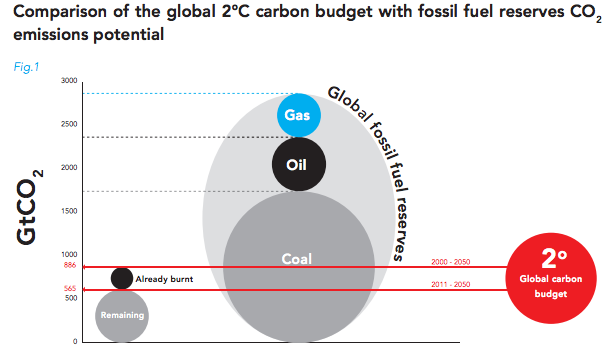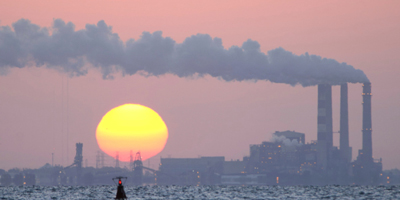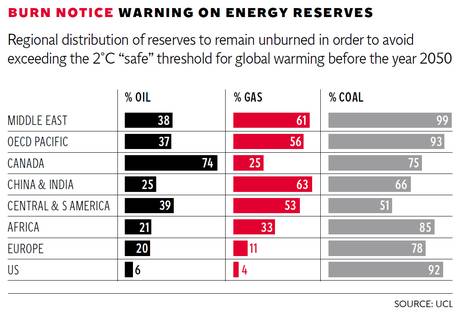January 8, 2015 – University College London researchers state that to achieve a goal of limiting atmospheric temperature rise to 2 Celsius (3.6 Fahrenheit) degrees, 85% of viable oil sands reserves will have to stay in the ground in perpetuity. That means by 2050 Alberta and Saskatchewan oil sands producers will be limited to extracting only 7.5 billion barrels more.
The Brits aren’t picking on the oil sands per se. Their study entitled “The geographical distribution of fossil fuels unused when limiting global warming to 2 degrees Celsius,” which was published yesterday in the journal Nature, makes the assumption that greenhouse gas emissions must be controlled so that temperatures do not exceed 2 Celsius degrees throughout the 21st century. That means the cumulative carbon emissions from the year 2011 to 2050 cannot exceed 1,10o gigatons of CO2. Where does that number come from? It is the one that The Intergovernmental Panel on Climate Change has set as the budget for further CO2 emissions to keep global warming from exceeding 2 Celsius degrees.
The authors of the study have taken an integrated assessment of oil, gas and coal reserves. They have regionally distributed production of fossil fuels to stay within the 1,100 gigaton limit. The results suggest the following distribution that should remain permanently in the ground:
- 80% of all global coal reserves.
- 50% of all natural gas reserves.
- 33% of all oil reserves.
Over and above these restrictions, if we were to burn all current proven fossil fuel reserves, the gigaton limit would be exceeded by more than 300 per cent. And if we added estimated reserves that number would be surpassed by 1100 per cent.

In evenly distributing the bad news the authors try to be fair. They have suggest the following regional impacts on proven reserves.
For Canada it means leaving 85% of the oil sands, 80% of the coal and 25% of natural gas proven reserves in the ground. For the oil sands that means no more than 7.5 billion barrels can be produced between 2011 and 2050. At close to 2 million barrels a day in current production that amounts to 730 million barrels per year or ten more years before the oil sands have to be shut down. And the ten year number is based on current levels of production which are far below estimates from the Canadian Association of Petroleum Producers who expect oil production to reach 3.91 million barrels per day this year and have forecast growth to 6.44 million by 2030.
The current Canadian government response to this study is one for the ages. Natural Resources Canada stated, “The majority [of the world’s energy] will come from fossil fuels, even under its most stringent greenhouse gas reduction forecast. The choice is whether to use energy from a secure, environmentally responsible, transparent country like Canada, or to seek energy from less stable countries without responsible environmental policies.”
In the study new fields are not in consideration and according to the authors shouldn’t be undertaken without offsetting fossil fuels already in proven reserves. That means forget exploring the Arctic Ocean Basin for offshore oil, and ending further exploration for sources of oil and natural gas in deep water.
Professor Christophe McGlade, one of the authors of the study comments, “Nearly all politicians across the world would like to develop all domestic sources of oil and gas and coal that they have and also search for new resources.” This suggests inconsistency in policy positioning because as McGlade further states, “Every country can’t exploit all of their domestic reserves and keep to two degrees.”
So what should governments be doing with all the current exploration, all the new fields being discovered through methods like hydraulic fracturing (fracking)? The authors suggest that governments have to determine where to take away the proven reserves from existing fossil fuel sources to meet global climate change limits. So, for example, if a new gas field is brought into production then maybe a coal mine is closed.
For the coal producer beholding to shareholders this has powerful implications. Proven reserves become unburnable assets. Should government then provide some form of compensation or should market forces prevail?
On the other hand there is a technological solution for fossil fuel companies. It is carbon capture and sequestration (CCS). But to-date only one commercial CCS project is operating in North America, the Saskatchewan Boundary Dam, an old coal-fired power plant that captures CO2 from smokestack gases and pumps the gas as liquid to old oil fields in neighboring Alberta. Of the 34 other CCS projects on the go, most are small scale or pilot studies. Fossil fuel companies have often pulled the plug on CCS projects leaving government funding partners holding the bag. So at best they appear lukewarm to the prospect of investing in large scale CCS as a way out. Yet that may be their best strategy.
As physicist Peter Eisenberger of the Lamont-Doherty Earth Observatory at Columbia University, New York, recently stated, “Any solution that doesn’t take carbon from the air is, in principle, not sustainable.” There certainly is incentive for energy producers to invest in CCS. Captured CO2 when pumped underground can up the extraction levels of old oil fields while permanently trapping the carbon. Power plants running on fossil fuels can be the producer of the captured CO2 making it a salable commodity rather than a pollutant. The fossil fuel companies gain in additional reserves can then be further offset by additional CCS projects that capture even more carbon when the fuel gets burned. For the energy companies it means those proven reserves can stay on their balance sheets and are no longer unburnable.






















[…] Much of Alberta’s Oil Sands Can’t Be Burned State Climate Scientists in Latest Report […]
[…] of the complexities of the topic. In particular, a number of activists have been claiming that 85% of the oil sands must remain in the ground as unburnable. As I will demonstrate below, this claim is not a scientific fact, but rather a political one. The […]